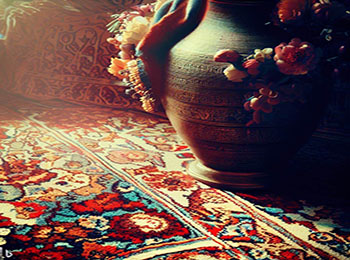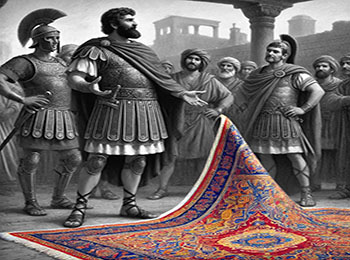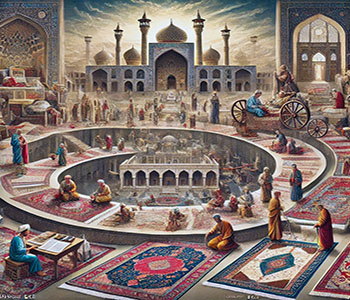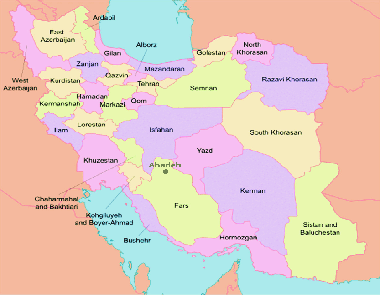Iranian rugs in warehouse stock. Original Persian rugs with certificate of origin. View our collection of Iranian Persian carpets and order online from our carpet webshop stock. Don't worry if the carpet doesn't match your intended room, CarpetDepo carpet shop offers a 30-day money-back guarantee and free returns.
Original Persian rugs – why invest in timeless quality?
- Authentic Persian rug made in Iran – cultural authenticity – produced using heritage methods in renowned weaving regions
- Handmade Iranian rug with tribal designs – expressive detail – unique symbols and patterns rooted in local tradition
- Persian rug with floral patterns for classic interior – refined aesthetics – ornamental motifs suited to elegant, heritage-inspired décor
- Iranian rugs for modern minimalist homes – visual harmony – enhances contemporary spaces with warmth and subtle complexity
- Persian rugs in multiple sizes available online – versatile options – appropriate for compact city apartments and spacious classic homes alike
- Natural wool Iranian rugs with plant-based dyes – responsible materials – crafted from eco-conscious fibres and traditional dyeing methods
- Persian rugs online shopping with EU delivery – convenient access – fast, secure shipping from our European warehouse with full tracking included
- Ongoing offers on Persian rugs – take advantage of favourable prices on selected models without compromising on quality
Explore our range and choose the original Persian rug that will not only decorate your home, but also represent long-term value and reliability. Whether you are looking for a handmade Iranian rug for a classic living room or a natural motif for a modern interior, you will find the ideal Persian rug in our collection. Browse our selection and order with confidence, with expert assistance and reliable service.
Find out more about Risk-FREE SHOPPING
Persian rugs for lovers of tasteful interior design
Iranian handmade Persian rugs are an excellent choice for those who value tradition, elegance, and craftsmanship. Enhance your living room with an authentic Persian rug made in Iran, offering timeless beauty and cultural depth. All items are in stock and available to order from our online carpet store, with fast and reliable delivery across the EU. Taking pride of place among Persian rugs, our handmade Iranian rugs create a stunning and atmospheric presence in both modern and classic interiors.
Made from wool, cotton fibres, these exquisite rugs are characterised by sophisticated knotting techniques. Their elegant and intricate patterns are the result of highly skilled manual craftsmanship. The decorative motifs are often inspired by elements of nature – animals, flowers, and botanical forms – many of which also appear in traditional Iranian architecture. Colour symbolism plays an important role as well: shades may represent wealth, fortune, loyalty, power, or life itself. The dyes used are natural and are prepared by master artisans with generations of expertise.
Materials:
Wool is a natural textile and one of the most valued materials in Iranian carpet production. Cotton is typically used as the base (weft thread), providing the structure onto which the knots are applied. These handmade Iranian rugs with tribal designs are exceptionally durable and resist everyday wear and tear. The wool naturally repels dirt and stains, making the rugs easy to clean. Furthermore, it is flame-resistant and retains its original shape over time, as the fibres do not become permanently flattened under use. As the above illustrates, an Iranian rug is far more than a decorative item – it is a genuine work of art, comparable to a finely detailed painting.

Iranian rugs - origins and the first mentions
The origins of Iranian carpets date back thousands of years, when Iranian nomadic tribes began making these handmade rugs to protect themselves from the cold and to decorate their homes. The first Persian rugs probably appeared in a simpler form, but the delicate designs and intricate knotting techniques were developed early on. The first historical references to Persian carpets come from ancient Greek sources, such as the writings of Xenophon, who noted around 401 BC that Persian rugs were already a symbol of luxury and wealth. One of the most famous and earliest surviving examples is the Pazyryk carpet, dating from the 5th century BC, found in a tomb in the Altai Mountains. This rug demonstrates not only the high level of knotting technique, but also the importance of Persian carpets in trade and cultural relations. The production of Iranian rugs has continued to evolve since then, but the first references to them show that they were highly valued even in ancient times.

Iranian handmade rugs History: 500 BC - 200 AD
The history of Persian rug making began around 500 BC, when the Achaemenid Empire was flourishing. By this time, rugs were not only part of everyday life, but had become a symbol of luxury in royal courts and palaces. Achaemenid kings such as Cyrus the Great and Darius were famous for their wealth, and the carpeted halls of their palaces reflected the grandeur of the empire.
The next important period for carpet making was the Seleucid Empire (330 BC - 150 BC) and the Parthian Empire (247 BC - 224 AD). During this period, the art of carpet making continued to develop, new weaving techniques were introduced and carpets became more refined and detailed. By the Parthian period, Persian rugs had reached the Roman Empire, where Persian handicrafts had become highly sought-after luxury items. The history of Persian carpets in Iran has been one of continuous development and refinement over the centuries.
Handmade carpets have always been an integral part of Persian culture and identity, and the knotting technique has been passed down from generation to generation. During the Sassanid Empire (224 - 651 AD), carpet weaving became a true art, and the finest pieces were used in the royal courts, palaces and mosques of the empire. During the period of Islamic conquest and the Caliphate (from the 7th century onwards), Persian carpets received new inspiration from Arab artistic influences. Islamic decorative motifs, geometric shapes and calligraphy appeared in the patterns of the carpets and further enriched the visual world of Persian carpets.
During the Safavid dynasty (1501-1736), Persian carpet making reached new heights. A system of carpet making was established, which extended to all corners of the empire. The city of Isfahan became the centre of carpet making. Persian rugs were famous worldwide for their detailed designs, sophisticated techniques and high quality.

Persian carpets on CarpetDepo: Main types of Iranian carpets
Moud Persian rugs, which stand out among the famous Iranian rugs, are made in one of the small weaving centres in Khorasan. These Iranian carpets, made near the Afghan border, appear in small quantities on the carpet market. Moud Iranian rugs have a distinctive colour palette of dark tones and rich hues that create a perfect harmony. The multi-pointed medallions that dominate their decoration often fill the entire surface, while the permanent motifs of Herati or Boteh designs can also be seen. These Iranian Persian rugs are made with cotton warp and weft yarns, while the knotting technique is extremely fine and the knot density varies from around 300,000 knots per square metre. The wool yarns are short-cut, glossy and particularly soft to the touch, making Moud Persian carpets some of the finest in Iranian carpet making.

Heriz, a small town near Azerbaijan, has become a famous weaving area where the famous Heriz Iranian rugs originate. This town is known for the superior quality of Persian carpets made in its workshops. The Heriz Medallion pattern, which is highly unique, is a defining feature of these Iranian carpets. Heriz Persian carpets are characterised by their fine knotting and are relatively rare. The central medallions are richly decorated and are characteristically rectangular, with arabesques, palmettes and rosettes on the borders. Heriz Iranian rugs are made from cotton warp and weft yarns and may also contain silk contour threads. These Iranian Persian rugs are made using Turkish knotting techniques, using high quality wool where the knot density can exceed 600,000 knots per square metre. Heriz Iranian rugs are among the best in the Persian carpet market and will retain their value for many years.
The typical colours of Abadeh Iranian rugs are brick red and beige, as well as light blue, in line with recent trends. Contrasting and contouring shades include various shades of red and blue. Three main patterns can be distinguished in Abadeh Persian carpets: the first is the stripe pattern typical of older antique pieces. The second is a hexagonal motif decorated with small floral or leaf ornaments, often with an octagonal four-leaf clover in the centre and corners, in light colours, filled with typical Abadeh elements. The third rarely used pattern is the repeated motif of a bouquet of flowers. The borders usually consist of three wide stripes and several thin layers, which create a kind of picture frame effect. The warp yarns are made of finely spun cotton, while the weft yarns are often made of blue-dyed cotton. The knotting is traditionally done using Persian techniques with a density of approximately 160,000 knots/m². The knots are made from thick, glossy wool, which is usually slightly soft to the touch and has a medium to high pile. Abadeh Iranian Persian rugs are excellent for decoration and are generally of a higher quality.
Shiraz rugs are made in the southern region of Persia, where the heritage of the past and modern business are both present. Rug making is one of the main activities in the region, where Shiraz Persian rugs have been made since the 19th century. Shiraz is the centre not only for these carpets but also for the Afshar Persian carpet trade.
Kerman Iranian carpets with early traditional designs have become particularly popular in the global carpet market. The city of Zarand serves as a major production centre for Kerman Persian carpets. Made using traditional techniques and natural dyes, Kerman Iranian Persian rugs are typically produced in bright shades of red or blue. Kerman rugs feature a variety of Persian and Western floral motifs. Striped, medallion, mirror, garden, animal, hunting and pictorial designs are also found. Cotton warp and weft yarns are typical of Kerman Iranian rugs. The carpets, made mainly by men in urban workshops, are made with dense Persian knotting, which can reach 620,000 knots per square metre. The quality of the wool is high and soft to withstand intensive use.
The colour palette of Isfahan carpets is very rich, with reds and browns, greens and yellows dominating alongside whites and ivories. Dyes made from natural materials create harmonious colour combinations in Isfahan Persian rugs. Among the most popular designs are Isfahan rugs with garden motifs decorated with flowers and vines, while other pieces feature latticework patterns with flowers, which are detailed and well-crafted Medallion rugs. The warp and weft yarns are made from cotton, with a dense knotting of around 550,000 knots per square metre. The quality of the wool is excellent and lustrous, and the fibre height is medium.
The dominant colours in Yazd Persian rugs are subtle shades of blue and purplish red, contrasted by white, light blue and pink. The carpets have a harmonious, if sometimes slightly sombre, overall appearance, decorated with floral patterns and geometric floral designs in endless repetition, and Medallion and Paradise patterns are common. Yazd Iranian carpets are made from cotton and wool warp yarns in densities ranging from medium fine to very fine, i.e. 100,000 to 500,000 knots per square metre. They are made from high quality wool.
The economy of the city of Nain is mainly based on the production and trade of high quality Iranian carpets, which are sold in global markets. The most typical colours of Nain carpets are shades of light blue, white, ivory and light grey. The decorations of Nain rugs are mostly small, delicate arabesques, precisely worked palmettes, rosettes and leaf patterns. The materials used include very finely spun cotton or natural silk. Nain Iranian carpets are made using Persian knotting techniques with a density of around 350,000 knots per square metre, while silk carpets are made with densities of up to 1,000,000 knots per square metre. Materials used often include fine Kurk wool, which is often combined, for example, with silk contours to create an embossed effect. Nain carpets are essentially short cut. Nain Iranian carpets are of the highest quality, durable and decorative, making them an excellent investment opportunity because of their potential to become valuable antiques in the future.
Interested in original Persian rugs? Explore our local sites in your language:
- Magyar – carpetdepo.com
Eredeti perzsa szőnyegek közvetlenül az importörtől – kézzel csomózott mesterművek, kedvező árakon, gyors kiszállítással Magyarországon belül. - Română – carpetdepo.ro
Covoare persane originale – lucrate manual, cu modele autentice și livrare rapidă în toată România. - Polski – carpetdepo.pl
Oryginalne dywany perskie – ręcznie wiązane arcydzieła z szybką dostawą na terenie Polski i atrakcyjną ceną. - Slovenský – carpetdepo.sk
Originálne perzské koberce – ručne viazané s dôrazom na kvalitu, rýchla doprava v rámci celého Slovenska. - Český – carpetdepo.cz
Originální perské koberce – ručně vázané s bohatými vzory a rychlým doručením po celé České republice. - Deutsch – carpetdepo.de
Originale Perserteppiche – handgeknüpfte Qualitätsteppiche mit schneller Lieferung in ganz Deutschland und Österreich. - Française – carpetdepo.fr
Tapis persans original – tissés à la main avec savoir-faire, livraison rapide et prix compétitifs en France. - Slovenski – carpetdepo.si
Originalne perzijske preproge – ročno vozlane umetnine z zanesljivo dostavo po vsej Sloveniji.
Browse our stunning range of Iranian rugs and choose the colour, pattern, shape and size to suit your needs!
Looking for a reliable online carpet shop in your language? Explore our country-specific sites:
- Magyarország – carpetdepo.com
Online szőnyeg áruház kézi és gépi szőnyegekkel – nagy választék, kiváló árak, gyors szállítás Magyarországon belül. - Romanian – carpetdepo.ro
Magazin online de covoare cu o gamă variată de modele manuale și mecanizate – livrare rapidă și prețuri avantajoase în România. - Polski – carpetdepo.pl
Internetowy sklep z dywanami – szeroki wybór dywanów ręcznych i maszynowych, atrakcyjne ceny i szybka dostawa na terenie Polski. - Slovensko - carpetdepo.sk
Online obchod s kobercami – ručne a strojovo tkané koberce, široký výber a rýchle doručenie po celom Slovensku. - Česká republika – carpetdepo.cz
Online obchod s koberci – bohatá nabídka ručně i strojově tkaných koberců, skvělé ceny a rychlé doručení v rámci České republiky. - Deutschland und Österreich – carpetdepo.de
Ihr Online Teppichshop mit großer Auswahl an handgewebten und maschinell gefertigten Teppichen – faire Preise und schnelle Lieferung in Deutschland und Österreich. - France – carpetdepo.fr
Magasin en ligne de tapis – vaste sélection de tapis tissés à la main et mécaniquement, prix compétitifs et livraison rapide en France. - Slovenija – carpetdepo.si
Spletna trgovina s preprogami – bogata ponudba ročno in strojno tkanih preprog po ugodnih cenah z ekspresno dostavo po Sloveniji.




































